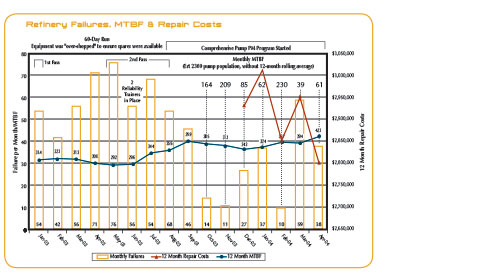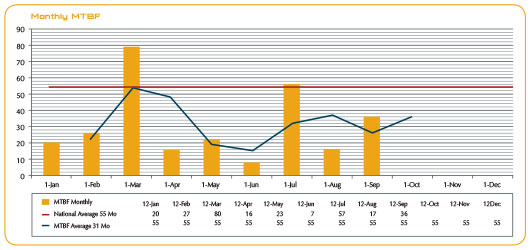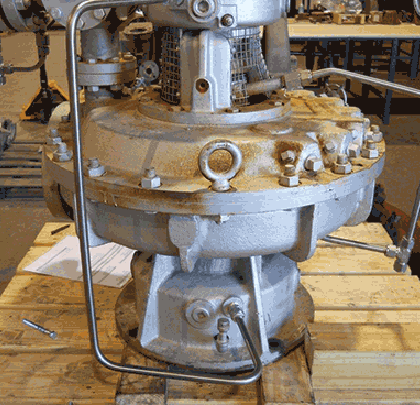Rotating machinery has an expected life cycle based upon engineered rate of wear due to load, lubricity and speed. Our predominant speed for machinery in this refinery is 3600 revolutions per minute. Our process requires Charge Pumps to perform under extreme loads and temperatures limiting the expected life of the rotating parts in the pump. However, our product being pumped is a hydrocarbon (paraffin based) with high lubricity qualities increasing life. The main detractor to lubricity in our product is the particulates or solid abrasives floating in the fluid stream which cause wear in the rotating to stationary parts of our pumps.
A rotating machine begins to diminish in life immediately upon start-up, loses operating longevity every hour thereafter, becomes more maintenance dependent at mid-life and finally causes multiple shut-downs for back to back mechanical seal replacements. No decision by the managers of maintenance/operations to maintain a machine which has expired in life cycle will be usurped as the rotating machinery will decide for management, when it chooses to stop operating due to mechanical malfunction. Our PdM process is for the “prepared mind.”
MANUFACTURED QUALITY
A manufacturer constructs machinery with a specific life expectancy for purchase cost/sales ($/hour) ($/barrel), sets the parameters for installation, establishes a guide for preventive maintenance to achieve the life cycle goals, places operational limitations (pump curves) upon the client and provides a complete support network for repair-overhaul-replacement-sales or operational/mechanical training. The quality of the machinery is controlled by machined tolerances, precision balancing and professional assembly utilizing the stringent guidelines of the API (American Petroleum Institute).
A manufacturer may design, construct and sell a particular machine with no knowledge of its actual application in the field until there is a claim presented against a manufacturer for warranty or liability. We should be aware of pumps being designed for a certain service, but purchased for installation into another service which may be volatile, rendering the application as less than desirable regarding integrity, safety and expected life. Upon disassembly, we would discover the internal component wear as non-conducive to the product or parameters or both when compared with original equipment design strategy.
A manufacturer must be given precise product composition, a range of operating conditions, horse power requirements, terrain elevation (feet above sea level), sealing requirements, and so on for the metallurgy, efficiency, and energy consumption (cost) meeting the client’s stated requirements. All rotating machinery should come with a documented “expected life cycle” goal as the base-line for measuring every aspect of performance (a function of purchasing-necessary to determine bid value versus investment cost).

WARRANTY PERIOD
Warranty is driven by competition between manufacturer’s leveraging their product with trouble free operating cycles of six months to one year with various conditions such as strict adherence to PM/PdM procedures, manufacturer representation upon start-up, or factory authorized alignments.
For example, a major equipment failure within the first year of operation must be evaluated for the following reasons using these priorities:
- Design comparison to client installation/operation
- Engineered quality matching the pump with the process parameters
- Manufactured quality of materials compared to process environment
- Manufactured quality of craftsmanship during assembly
- Damage from transportation or long term storage (asset preservation)
- Contractor quality of installation following manufacturer guidelines
- Start-up quality measured by the number of failed start attempts and low flow conditions (standard of excellence is one start)
- PM/PdM cycle management program
- Vibration, temperature, pressure, and flow rate data
- Operations ability to maintain flow rates as designed
RE-MANUFACTURED QUALITY
A work scope based upon time allowed for a pump to be out of service changes the expected life cycle of the pump immediately upon its return to service. Anytime a pump is put back into service in less than new condition, the life cycle has been altered and the budget must be recalculated to account for the change. The client (operations) should be notified of the change in due date for “date of next overhaul” for budgetary, planning and input by operations for future decisions/goals.
The primary concern by maintenance and operations should be the possibility of time expiration of machine “A” occurring at or near the same expiration cycle of machine “B,” which increases the risk of an unscheduled unit/plant outage.
The secondary concern relates to the parasitic costs involved to take a machine back out of service due to the subsequent short run-time.
- Operations loses efficiency
- Process costs increase due to batch slop (recycle cost)
- Operations uses man power to prepare the machine for removal
- The Client is at risk again without a redundant system
- Pipe fitters may be involved
- Fresh air may be required
- Lifting equipment may or may not be available
- Electricians may be involved
- Transportation will be required
- Decontamination will be required
- Supervision from the zone to bundle wash to the shop is required
- Re-installation duplicates the cost of removal
- The risk of leaks may be increased due to human intervention
- The risk of fire may be increased due to human intervention

UNDERSTANDING THE CLOCK AND THE COSTS
The only new money that should be spent would be for the new machine work and new materials to bring machinery back to new condition. We may then reset the expected life clock as the machinery has full expected life capability. The clock may be set to measure full life as 43,800 hours, or five years, for example. We would not reset the clock for life cycle unless previous history provides data to support the incomplete overhaul “expected life performance.”
Incomplete overhauls or partial refurbishments simply “pause” the clock (hours out of service), which continues to be measured from the date of last major overhaul. For example, if one considers a major overhaul expected life of 43,800 hours and a minor overhaul expected life of 17,500 hours, then the cost differentials become clear.
If one calculates $0.91 per hour for the 43,800 hours of a major overhaul for a cost of $40,000 and the minor overhaul cost at $1.14 per hour for 17,520 hours, creating a total is $20,000, these benchmarks provide clearer reference points for repair than simply saying “major” or “minor” in and of themselves.
However, on average, if minor overhaul cycle costs are 2.5 times the major overhaul expectations (meaning that minor overhaul occur 2.5 cycles to one budgeted major overhaul cycle), then the life cycle hours for minor repairs must be factored not at 17,520 hours, but at 43,800 (17,520 x 2.5).
The total impact to cost is as follows: A minor overhaul costs $1.14 per hour for 2.5 overhauls per life cycle, which equals $2.85 per hour of actual cost to budget. The impact of a minor overhaul in this example shows the cost increases over 3 times that of the budgeted major overhaul ($0.91/hour), which achieves full operating expected life. A budget expenditure alarm level could be set to notify management when the cost increases by 10 percent or $0.99 per hour.
In part 2 of this article, we will turn our attention to other influences on expected life cycle and their relation to maintenance costs, including the time allowed for rework/discrepancies once a machine is released to operations, the effects of installation quality, and the criteria for changing operational strategies. ■
_________________________________________________________________________
ABOUT THE AUTHOR
Steve Reynolds is the quality control manager for Texas Rotating Equipment, Inc. of Dayton, Texas, a leader in turbomachinery related products and services. He can be reached at 936.258.3090 or sreynolds@texasrotating.com. For more information, visit www.texasrotating.com.
_________________________________________________________________________
MODERN PUMPING TODAY, May 2013
Did you enjoy this article?
Subscribe to the FREE Digital Edition of Modern Pumping Today Magazine!
![]()


